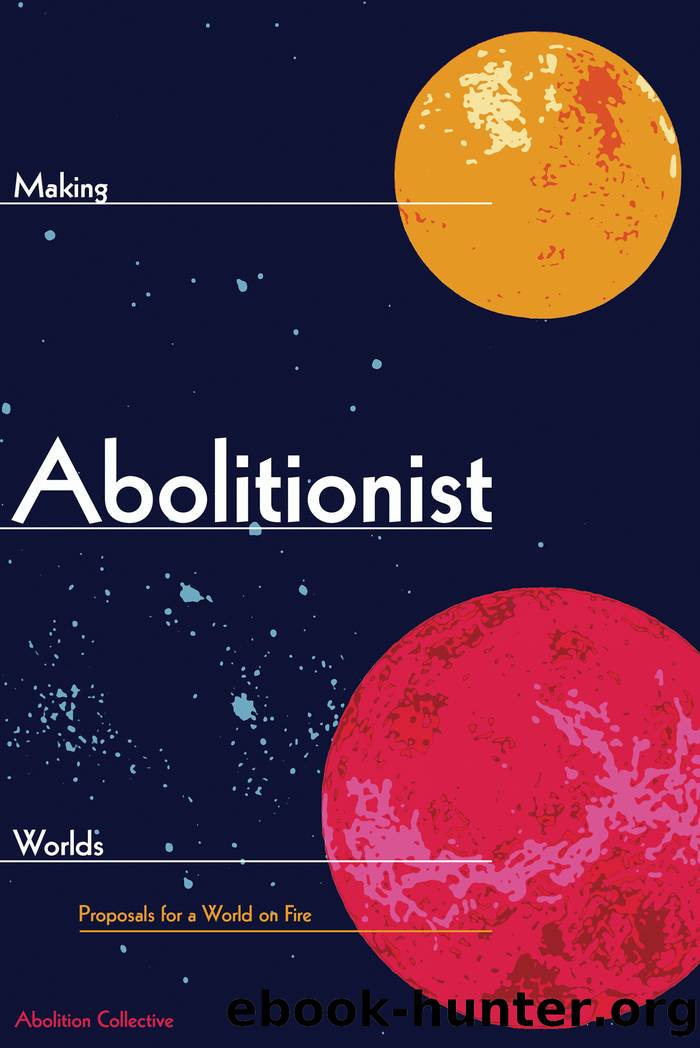Making Abolitionist Worlds by Collective Abolition;

Author:Collective, Abolition;
Language: eng
Format: epub
Publisher: Common Notions
Published: 2020-10-15T00:00:00+00:00
ECONOMIC AND PSYCHOLOGICAL WAGES OF WHITENESS AS SOCIOHISTORICAL CONSTRUCTS
At its most basic, race is about seeing and treating people differently in society based on historically constructed racial identitiesâa reinforcing process of defining and then treating people from racialized groups as less than human. This sociopolitical structure of race was the founding cornerstone of racialized chattel slavery, predating both industrialization and US independence. Despite real historical changes over time, race remains a sociopolitical order engrained in the US state and society. It is an order that has evolved through both challenges to the racial order by social movements and to meet the historically determined needs of the polity and economy.11 Throughout its history, race has been a core determinant of the US class structure and a political category that organizes where and how people live, with state and vigilante violence working at different times and in different ways to enforce a socio-geographic racial ordering of individuals and populations.
A consistent feature of the US racial order has been the intrinsic elevation of all whitesâregardless of occupation, education, wealth, or personal lifestyleâto a sociopolitical status higher than other racial groups. This stratification was instilled and reproduced through separate but reinforcing norms of social status (political rights and social privileges) and economic benefit (access to work, land, and other mechanisms for the construction of personal wealth). The economic advantages and disadvantages directly related to race (from slavery, to Jim Crow, to the postâcivil rights movement) have been accompanied by an evolving set of social privileges produced and maintained by political structures as well as social relations supported by various ideological incarnations of white supremacy. W.E.B. Du Bois articulated this political and economic stratification as a measurable set of wages (an economic wage and a social psychological wage) understood at different sociopolitical levels from individual consciousness to macro-level social relations. Du Bois explains the importance of the sociopsychological wages of whiteness as they intersect material advantages:
It must be remembered that the white group of laborers, while they received a low wage, were compensated in part by a sort of public and psychological wage. They were given public deference and titles of courtesy because they were white. They were admitted freely with all classes of white people to public functions, public parks, and the best schools. The police were drawn from their ranks, and the courts, dependent on their votes, treated them with such leniency as to encourage lawlessness. Their vote selected public officials, and while this had small effect upon the economic situation, it had great effect upon their personal treatment and the deference shown them. White schoolhouses were the best in the community, and conspicuously placed, and they cost anywhere from twice to ten times as much per capita as the colored schools. The newspapers specialized on news that flattered the poor whites and almost utterly ignored the Negro except in crime and ridicule.12
Download
This site does not store any files on its server. We only index and link to content provided by other sites. Please contact the content providers to delete copyright contents if any and email us, we'll remove relevant links or contents immediately.
| Anthropology | Archaeology |
| Philosophy | Politics & Government |
| Social Sciences | Sociology |
| Women's Studies |
Nudge - Improving Decisions about Health, Wealth, and Happiness by Thaler Sunstein(6629)
iGen by Jean M. Twenge(4692)
The Fire Next Time by James Baldwin(4336)
Adulting by Kelly Williams Brown(3662)
The Sports Rules Book by Human Kinetics(3581)
The Hacking of the American Mind by Robert H. Lustig(3575)
The Ethical Slut by Janet W. Hardy(3494)
Captivate by Vanessa Van Edwards(3292)
Mummy Knew by Lisa James(3163)
In a Sunburned Country by Bill Bryson(2940)
Ants Among Elephants by Sujatha Gidla(2919)
The Worm at the Core by Sheldon Solomon(2910)
Suicide: A Study in Sociology by Emile Durkheim(2606)
The Slow Fix: Solve Problems, Work Smarter, and Live Better In a World Addicted to Speed by Carl Honore(2570)
Humans of New York by Brandon Stanton(2376)
Handbook of Forensic Sociology and Psychology by Stephen J. Morewitz & Mark L. Goldstein(2376)
Blackwell Companion to Sociology, The by Judith R. Blau(2314)
The Happy Hooker by Xaviera Hollander(2271)
Outliers by Malcolm Gladwell(2254)
